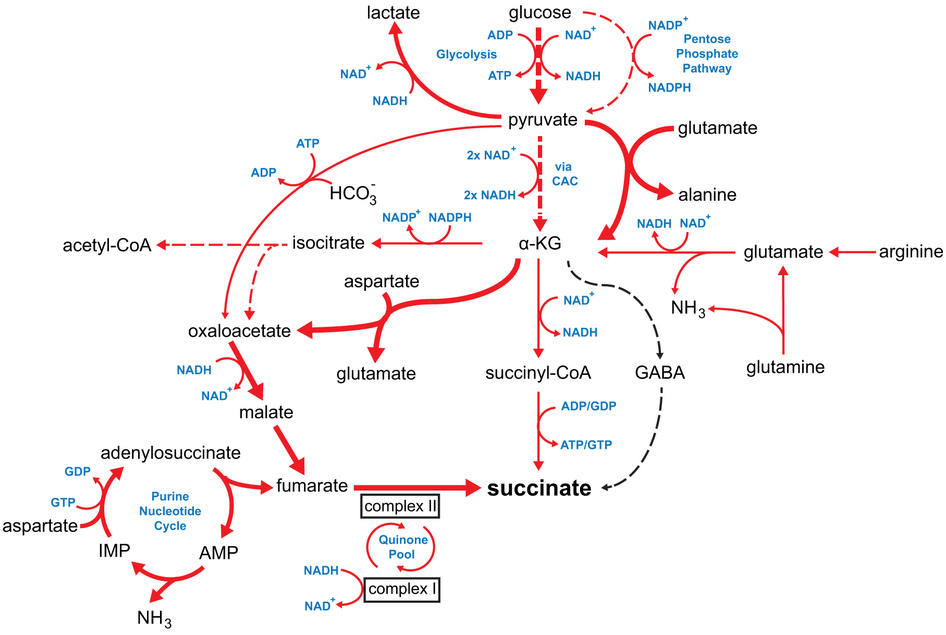博文
缺血再灌注损伤过程中活性氧产生的代谢基础
 精选
精选
||
缺血所引的组织损伤是致死性疾病的主要原因,诸如冠动脉硬化导致的心肌梗死、脑卒中等。重新恢复血流供应是挽救缺血组织的重要前提,科学家早就发现,缺血对组织造成损伤,不仅包括缺血导致能量供应不足,也出现在恢复血液供应后,恢复血液供应能导致组织细胞损伤进一步加重,这种因为恢复血流导致损伤叫缺血再灌注损伤。缺血再灌注后细胞死亡和免疫炎症反应会引起过量活性氧增加,导致组织氧化损伤,这是引起缺血再灌注损伤的关键因素。
缺血再灌注后细胞内线粒体会大量释放活性氧,但一般认为这是再灌注引起的一种非特异性反应。
最近《自然》发表最新相关研究,用体代谢组学分析方法意外发现组织缺血再灌注过程中细胞线粒体释放活性氧的一种传统代谢通路。

三羧酸循环是需氧生物体内普遍存在的代谢途径,分布在线粒体。因这个循环中几个主要中间代谢物是柠檬酸,含三个羧基,所以叫做三羧酸循环,又称为柠檬酸循环或是TCA循环,或以发现者Hans Adolf Krebs的姓名命名为Krebs循环。三羧酸循环是三大营养素(糖、脂、蛋白质)的最终代谢通路,也是糖类、脂类、氨基酸代谢联系的枢纽。理论上,如果组织缺血,三羧酸循环缺乏最终代谢出口,所有过程都有可能被中断,所有代谢产物都有可能发生积聚,实际情况可能只有某一个或少数几个化合物积聚。但是过去并不了解具体那种物质发生积聚,也不清楚这种积聚的化合物具有何种效应。琥珀酸(丁二酸)是三羧酸循环中的一种代谢中间产物。最新研究发现,在组织缺血过程中琥珀酸选择性积聚,而且这种积聚是导致再灌注期间线粒体大量释放活性氧的重要原因。

a, Various rat and mouse tissues exposed to sufficient periods of ischaemia to prime for reperfusion ROS production were subjected to targeted LC–MS metabolomics analysis and comparison of metabolites that accumulated significantly when compared to normoxic levels. After this, metabolites were scored according to the prevalence of their accumulation across five ischaemic tissue conditions. B, brain; H, whole heart ischaemia ex vivo; HL, left anterior descending coronary artery ischaemia in vivo; K, kidney, L, liver. b, Determination of linearity of the relationship between LC–MS metabolite peak intensity and concentration for CAC and related metabolites. c, Quality control determination of coefficient of variation for LC–MS quantification of CAC and related metabolites.
缺血导致琥珀酸积聚首先是因为琥珀酸脱氢酶逆转,该效应主要是因为ATP产生障碍导致延胡索酸过量,部分原因是苹果酸/天冬氨酸穿梭翻转。再灌注期间,积聚的琥珀酸迅速被琥珀酸氢化酶催化氧化,线粒体电子传递链复合物I被抑制导致大量产生活性氧。采用药物方法抑制缺血过程中的琥珀酸积聚能有效对抗动物心脏和脑缺血再灌注损伤。
 Time course of succinate levels during myocardial ischaemia and reperfusion for the in vivo heart (5 min and 15 min ischaemia n = 4; 30 min ischaemia n = 9; 5 min reperfused n = 5). b, Summary of the three potential metabolic inputs for succinate-directed ischaemic flux. To understand the metabolic pathways that could contribute to succinate production under ischaemia, an updated version of the iAS253 model of cardiac metabolism11 was used to simulate ischaemia using flux balance analysis. The model showed three possible mechanisms for producing succinate: from α-ketoglutarate produced by the CAC, derived from glycolysis, fatty acid oxidation, and glutaminolysis (grey box), from succinic semialdehyde produced from the GABA shunt (blue box), and from fumarate produced from the malate-aspartate shuttle and purine nucleotide cycle (red box) via the reversal of SDH. Data are mean ± s.e.m. of at least four biological replicates.
Time course of succinate levels during myocardial ischaemia and reperfusion for the in vivo heart (5 min and 15 min ischaemia n = 4; 30 min ischaemia n = 9; 5 min reperfused n = 5). b, Summary of the three potential metabolic inputs for succinate-directed ischaemic flux. To understand the metabolic pathways that could contribute to succinate production under ischaemia, an updated version of the iAS253 model of cardiac metabolism11 was used to simulate ischaemia using flux balance analysis. The model showed three possible mechanisms for producing succinate: from α-ketoglutarate produced by the CAC, derived from glycolysis, fatty acid oxidation, and glutaminolysis (grey box), from succinic semialdehyde produced from the GABA shunt (blue box), and from fumarate produced from the malate-aspartate shuttle and purine nucleotide cycle (red box) via the reversal of SDH. Data are mean ± s.e.m. of at least four biological replicates.
这一研究确定了缺血再灌注损伤过程中的经典代谢过程发生的变化细节,这种传统代谢产物的变化是导致缺血再灌注损伤过程中活性氧产生的重要根源。这一研究也提供了一种在体控制活性氧产生的新策略,只需要设法抑制缺血过程中细胞内琥珀酸积聚,或者抑制再灌注过程中琥珀酸被快速氧化,就可以实现治疗组织缺血再灌注损伤的目的。
 To identify the metabolic pathways that could contribute to succinate production under ischaemia, we simulated these conditions using flux balance analysis in conjunction with an expanded version of the iAS253 mitochondrial model of central cardiac metabolism. The major pathways contributing to succinate accumulation (bold red lines) were via fumarate feeding into the reverse activity of SDH. This was produced by the PNC and the MAS, which consumed glucose and aspartate, and also led to significant production of lactate and alanine. Lesser sources of succinate (thin red lines) included glycolysis and glutaminolysis but this was relatively minor as this route was constrained by the overproduction of NADH. In addition, a small amount of fumarate was generated by pyruvate carboxylase activity. The GABA shunt did not contribute (black dashed line).
To identify the metabolic pathways that could contribute to succinate production under ischaemia, we simulated these conditions using flux balance analysis in conjunction with an expanded version of the iAS253 mitochondrial model of central cardiac metabolism. The major pathways contributing to succinate accumulation (bold red lines) were via fumarate feeding into the reverse activity of SDH. This was produced by the PNC and the MAS, which consumed glucose and aspartate, and also led to significant production of lactate and alanine. Lesser sources of succinate (thin red lines) included glycolysis and glutaminolysis but this was relatively minor as this route was constrained by the overproduction of NADH. In addition, a small amount of fumarate was generated by pyruvate carboxylase activity. The GABA shunt did not contribute (black dashed line).
http://www.nature.com/nature/journal/vaop/ncurrent/full/nature13909.html
https://blog.sciencenet.cn/blog-41174-841562.html
上一篇:偷渡突破血脑屏障
下一篇:氢气将对人类健康带来重大影响